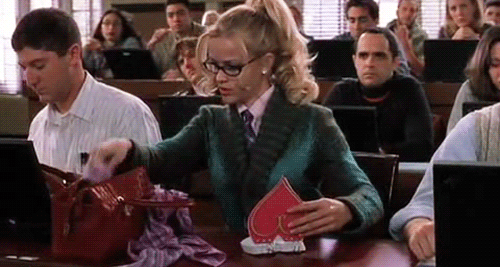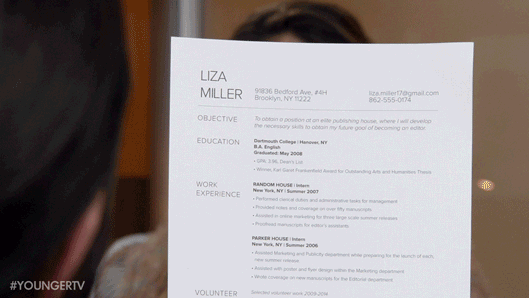Resumes.
We all know what they are.
We all know how important having a good one is…and how much a bad one can hurt your ability to get your dream job.
We also know we aren't the only ones out there turning in well crafted, carefully targeted resumes to hiring managers…
Unfortunately for you, for every available job out there in the real world, there are hundreds, if not thousands of very qualified people applying…and odds are, there are more than a few really knock-dead resumes in that pile.
Of course, there are also a mountain of bad ones that won't even make the first cut. But of those that do…how do you make sure yours stands out?

You could always go for the Elle Woods approach. Remember in the movie Legally Blonde when our spunky and upbeat heroine hands her resume off to her professor in the hopes of securing that killer summer internship?
Professor Callahan: It's pink…
Elle: Oh! And it's scented! I think it gives it a little something extra…don't you think?
You have to admit, that is one way to make an impression with a hiring manager…however, outside Hollywood fantasies where the hero always gets their way (or in this case, the internship), odds are your pink scented resume is going to end up either in the trash or on the bulletin board "Wall of Shame" as an example of what NOT to send in to a hiring manager.

So put away your sparkle pens, cap your smelly perfume, and sit back because I'm going to help you stand out from the crowd…for all the right reasons.
Here's a secret: everyone, seriously everyone, hates crafting resumes.
Here's another secret: you're making it harder than it needs to be.
Step 0: Do NOT fire up Microsoft Word and use a generic resume template.
Absolutely, positively, do NOT do this, no matter what. Microsoft Word is a powerful program, but just firing it up and opening up one of the included resume templates does one thing and one thing alone – make your resume look like everyone else's. You want your resume to look unique and memorable, but classy – Word's default templates will not set you apart.
Step 1: Open a plain text document and start listing all of the information you might ever include on a resume

List the details of every job, including every possible relevant accomplishment at each one. List every organized activity you've ever participated in, and every noteworthy honor you've received in your life. List everything.Tip #1: If you don't know where to start, include the following in this order:
Work experience (dates, names of employers, location, tasks, accomplishments)
Education (dates, degrees obtained, location)
Specific skills
Honors and awards
Other activities of note (professional organizations, special skills, Community Service etc.)
This is essentially your "default resume." You're never going to send it to anyone. Instead, you're going to use it to quickly build the real resumes that you will send to potential employers.
Step 2: Read and research the job you're interested in applying for

Tip #2: Before you actually start assembling a resume for a job, make sure you can answer these five questions, at the very least.
What is the likely primary function of the job? What are you being hired to do? This isn't your job title, but what you will actually be doing.
What is the organization that I'm applying to? Sure, you know the name of the organization, but what is that organization's function? Do they produce certain products? Do they provide certain services?
What is the reputation of this organization? Applying to Google and to "Joe's Desperate Search Engine" are two completely different things, even though the jobs may appear very similar on paper. Joe is probably seeking a programmer with very specific skills, while Google is looking for people who exhibit exceptional problem solving skills.
What is my role within this organization? If you accept this job, what will your role be? Will you be working on developing the product directly, or will you be providing services to the public? Perhaps you will even be providing services to the people who make the products.
What skills and attributes point to success with this specific organization in the role I'm going to fill? Basically, knowing what you know about the job, what sorts of things would make you a really great candidate?
Tip #3: Open a new copy of your default resume and eliminate everything that isn't highly relevant or impressive

Tip #3: If you're early in your career, you may wish to list some jobs that don't match the description very well to establish a work history. That's fine, but go minimal on describing them.
What you have now is the information you want to put on the resume. Now, let's polish it up a bit.
Step 3: Make your accomplishments ring with action

Now it's time to polish up the statements about what you've done, focusing on two things: language that indicates that you've performed an action, and selection and modification of these statements to appeal to the organization.
First, go through and change all of the descriptions of your work tasks into action sentences. Let's work through three examples of this.
Bad job attribute: Participated in the development of a data entry program
Better job attribute: Developed a high-throughput data entry program in a team-based environment
Bad job attribute: Chaired three committees
Better job attribute: Led the creation of new company-wide policies
Bad job attribute: Introduced a new filing system and helped set it up
Better job attribute: Implemented a new document organization system
In each case, the move was towards verbs that indicate more decisive action that led to a desired result. Employers want actions that lead to results, not participation.
Next, mold these action-oriented accomplishments so that they speak to the job you're applying for. Let's look at that data entry program developer. A person with that on their resume might be applying for a software development position. In that case, one might want to highlight the code-based accomplishment:
Great job attribute: Wrote 22,000 lines of Adobe for a data-handling class for a high-throughput data-entry tool
On the other hand, if you're looking for a leadership job, you may want something like this:
Great job attribute: Led a team of seven to develop a high-throughput data entry program
In the end, you want to highlight those parts of the tasks you have done that will make you seem most exciting to the potential employer.
Step 4: Write a one sentence pitch explaining why your job attributes make you a good candidate.

Your resume should not have an objective on it. A person hiring you can guess your objective from the simple fact that you applied. Instead, you should have a statement explaining how your specific skills make you the right person for the job. Here's a good example.
I have nine years' experience developing high-throughput Adobe Dream cloud software and leading teams in the implementation of this software.
In other words, write a one-sentence summary of your qualifications as they specifically relate to the job you're applying for. This will go right at the top of the resume.
Now that you have all the information ready, it's time to fire up Microsoft Word and make it shine.
Step 5: Make a polished document out of the material you've created

I strongly recommend using Georgia as your font, as it is fairly distinctive while still quite legible in print, and I also recommend making your line spacing 120% (go to Format, choose Paragraph, choose Multiple, and set it to 1.2).
I also recommend putting things in the following order:
Name/address/phone/email
Summary of Qualifications
Work Experience (unless this is your first "real" job)
Professional Organizations (unless these are slim, the eliminate or move to end)
Honors (unless these are slim, then eliminate or move to end)
Education
A note indicating that references are available upon request
Ideally, you want this to be as short as possible. One page, with an additional cover letter, is best. If you feel the need to include more stuff, feel free, but every time you add something more to the resume, you provide more and more cover for your truly excellent attributes to hide in a sea of merely good attributes.
One last thing…

Remember, always, that you're trying to sell yourself to the company. Think of yourself as a product on the shelf, next to many competitors. How are you going to grab their attention in a positive way, show off your best attributes, and make them at least consider buying you (i.e., interview you)? Keep that in mind at all times when constructing your resume, and you'll do fine …no pink paper or perfume needed.
















